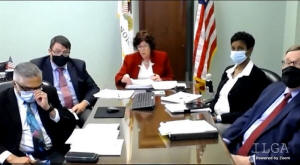Illinois Emergency Management Agency shares lessons learned from
pandemic
 Send a link to a friend
Send a link to a friend
[April 09, 2021]
By PETER HANCOCK
Capitol News Illinois
phancock@capitolnewsillinois.com
 SPRINGFIELD – The Illinois Emergency
Management Agency was forced to adapt quickly to a new role when the
COVID-19 pandemic first hit last year, and the agency’s director told a
legislative committee that more work needs to be done to prepare for the
event of another statewide disaster. SPRINGFIELD – The Illinois Emergency
Management Agency was forced to adapt quickly to a new role when the
COVID-19 pandemic first hit last year, and the agency’s director told a
legislative committee that more work needs to be done to prepare for the
event of another statewide disaster.
“Even though we provide resources to counties and local jurisdictions
during times of disaster, we really never had a logistical arm to the
organization. That has since changed,” IEMA Director Alicia Tate-Nadeau
told a Senate budget committee. “So overnight, we turned into a Fortune
500 logistical supply chain management system. And you can imagine the
lessons that are learned from trying to do that.”
One of the earliest challenges the agency faced in the first weeks and
months of the pandemic, she said, was trying to amass a stockpile of
personal protective equipment, or PPE – the face shields, gowns, gloves
and N95 masks needed to protect health care workers and first responders
who dealt directly with COVID-19 patients.
But it quickly became apparent that most of the PPE in the world either
came from outside the United States or the raw materials used for
manufacturing it did. And although the federal government maintained a
stockpile of PPE, Tate-Nadeau said, “the Strategic National Stockpile
was only meant for one or two cities across the nation, not for the
entire United States.”
“Whenever we think about, you know, vulnerabilities and how we could
improve things, it really comes down to manufacturing,” she said.
“Strong relationships with manufacturing, the ability to be able to
surge in certain areas.”
IEMA has since acquired two warehouses of its own, she said, including
one in Rochelle, in northern Illinois, and another in Pana, in central
Illinois. But she said a third one is needed in southern Illinois, where
there has long been a risk of a major earthquake.

“That one down south that is yet to be determined is critical should we
ever see the earthquake scenario,” she said. “That way, the southern
portion of the state is not cut off from the supply chain, because we
know everything from the southern portion of state all the way through
Tennessee, it's all going to be blocked off. Everything's going to have
to come in up north for resupply.”
Another lesson the agency learned, Tate-Nadeau said, is that more work
needs to be done to strengthen and professionalize local, county-level
emergency management agencies.
“Many of our smaller counties maybe have somebody who is just part time
or a third time, or just one person,” she said. “And what we do know is
that success in major events like this is about having someone who truly
understands emergency management. … Having the capability for each
county to be able to house 25 people during an event would have
precluded the state from taking such a large role.”
Tate-Nadeau’s comments came during a Senate committee hearing on the
agency’s proposed budget for the upcoming fiscal year, which begins July
1.
[to top of second column]
|

Alicia Tate-Nadeau, center, director of the Illinois
Emergency Management Agency, and members of her staff present the
agency's budget request for the upcoming fiscal year during a
virtual meeting of a Senate appropriations committee. (Credit:
ILGA.gov)

Overall, the agency is seeking a budget of just under $2.2 billion
for fiscal year 2022, or $404 million less than the current year.
That is due mainly to an expected decrease in federal funding, which
makes up about 84 percent of the agency’s budget.
It’s an increase of more than $100 million, however, from fiscal
year 2020, in which the COVID-19 pandemic began and disaster
preparation funds greatly increased. It’s also nearly four times the
enacted budget of fiscal year 2019, which is the final budget not
touched by the COVID-19 pandemic. That’s due to the federal aid that
began flowing in since March 2020.
One of IEMA’s main roles is to act as a pass-through agency that
receives federal funds for disasters and homeland security and
passes it on to other agencies.

The agency is requesting, and Gov. JB Pritzker proposed in February,
an increase of $3.5 million in allocations from the General Revenue
Fund, which is the main discretionary spending account that
lawmakers allocate each year. That would bring GRF funding for the
agency up to $11.35 million.
The added GRF funding would push the number of IEMA employees funded
through the General Revenue Fund to 58, up from 20 in the current
fiscal year. That would bring the agency’s total headcount to 213.5,
up 13 from the current fiscal year, with fewer employees supported
by federal and other state funds.
Tate-Nadeau said payroll accounts for only 13 percent of the
agency’s total operational budget.
The proposed budget calls for an overall $4.1 million decrease in
state funds when “other state funds” are considered along with
General Revenue funds. “Other state funds” come mainly from fees the
state charges that are dedicated to IEMA’s various missions. The
agency expects a $7 million decrease in the Nuclear Safety Emergency
Preparedness Fund, which is funded through statutory fees on the
nuclear power industry.
Tate-Nadeau said the agency has taken several steps to trim its
budget in light of the state’s stressed financial condition. That
includes reducing its request for new equipment by $1.4 million, cut
$1.2 million from its information technology request and reduced its
operational budget by $251,000.
“Over the years this agency has been saddled with attrition budget
constraints, hiring freezes, and has been left with bare bones staff
that is continually asked to do more to meet the 21st century
challenges,” she said.
Capitol News Illinois Bureau Chief Jerry Nowicki contributed to this
story.
Capitol News Illinois is a nonprofit, nonpartisan
news service covering state government and distributed to more than
400 newspapers statewide. It is funded primarily by the Illinois
Press Foundation and the Robert R. McCormick Foundation. |